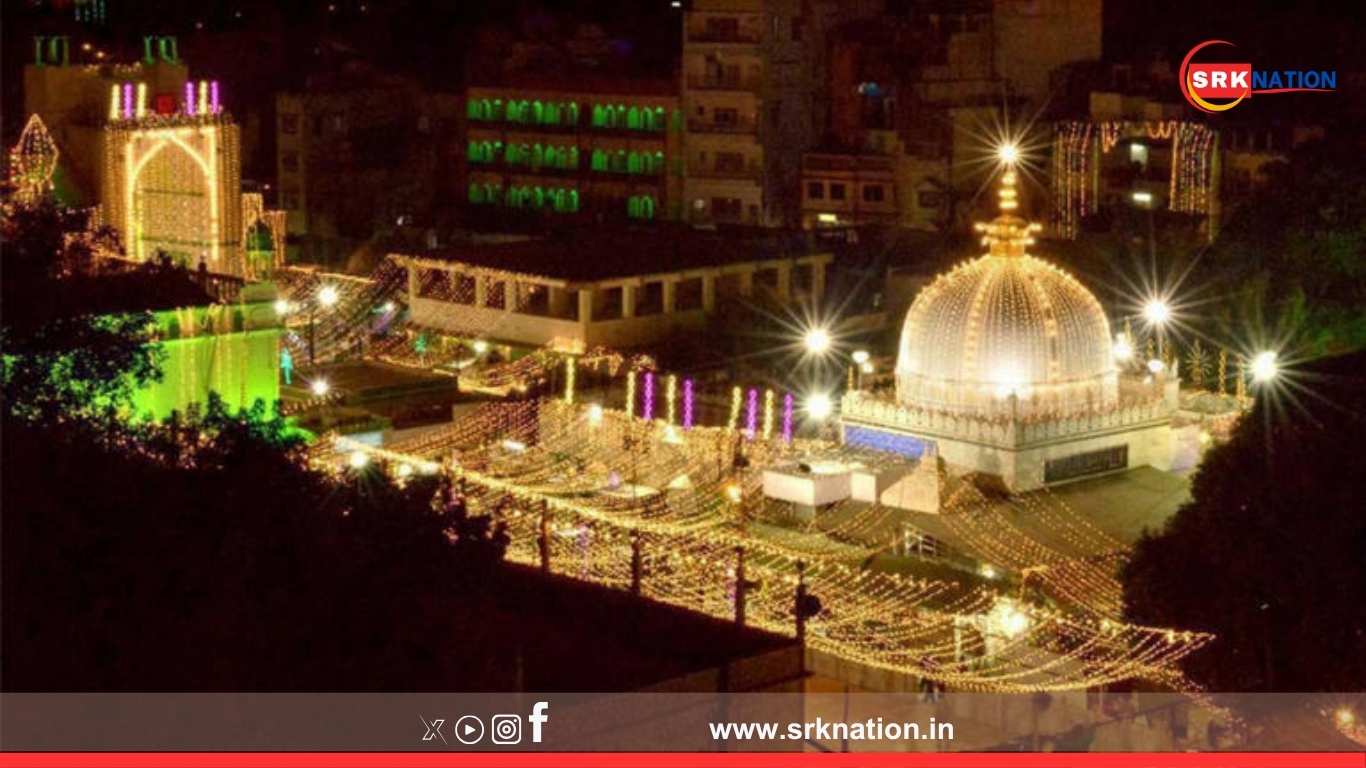A major safety scare unfolded on Monday at the historic Ajmer Sharif Dargah in Rajasthan when a portion of an old building collapsed within the shrine premises, triggering panic among devotees and raising serious questions over heritage maintenance and structural safety. Fortunately, no casualties were reported as the area was relatively less crowded at the time of the collapse.
What Happened at Ajmer Dargah?
According to dargah committee officials and local administration sources, a section of the roof and wall of the Nizam Gate side structure collapsed around 11 am. Debris fell onto a pathway frequently used by pilgrims, leading to chaos as volunteers cordoned off the area immediately to prevent injuries.
Khuddam (caretakers) and police teams swung into action to clear rubble and restrict entry to the affected part. Visuals circulating on social media showed large chunks of plaster, bricks, and wooden beams strewn across the premises, sparking concern over the structural integrity of other old buildings within the shrine complex.
No Casualties But Fear Among Devotees
Devotees present at the Dargah, one of India’s most revered Sufi shrines visited by millions annually, described the incident as frightening. Rehana Bano, a pilgrim from Bhopal, said:
“We heard a loud cracking sound, and the next moment, dust and debris filled the passage. Thankfully no one was underneath it.”
Dargah Committee and Khadim Associations Blame Neglect
The Anjuman Committee and Khadim Syedzadgan Association, which manage the Dargah affairs, squarely blamed the Centre’s ‘negligence’ towards the upkeep of the centuries-old shrine. They alleged that:
- The Central Waqf Council and Ministry of Minority Affairs have failed to allocate adequate maintenance funds despite repeated requests.
- Structural repairs and restoration projects remain pending for years, leading to weakening of old buildings.
Syed Sarwar Chishti, secretary of Anjuman Committee, said:
“The Centre collects huge revenue from Dargah tourism but fails to protect its heritage. We have written to Minority Affairs Ministry multiple times for restoration of the collapsed section and adjoining structures.”
Historic and Religious Significance of Ajmer Sharif Dargah
Ajmer Sharif Dargah, the shrine of Sufi Saint Khwaja Moinuddin Chishti, dates back to the 12th century and is a major site of pilgrimage cutting across religious lines. Key facts:
- Attracts over 10 million pilgrims annually, especially during Urs celebrations.
- Managed under the Dargah Khwaja Saheb Act, 1955, with oversight from the Ministry of Minority Affairs.
- Includes Mughal-era, British-era, and post-independence constructions within the premises, many requiring urgent conservation due to ageing.
Experts Warn of Structural Vulnerability
Heritage conservation experts have long flagged concerns over:
- Excess load on old structures due to unregulated footfall and encroachments.
- Lack of periodic structural audits, re-plastering, and water seepage repairs, leading to wood rot, rusting, and plaster detachment.
- Poor coordination between Archaeological Survey of India (ASI), Waqf boards, and local bodies for preventive maintenance.
Dr. Meera Sinha, heritage architect specialising in Islamic monuments, said:
“Such collapses are wake-up calls. The Dargah complex needs urgent structural audits, drainage upgrades, and traditional material-based repairs to prevent heritage erosion.”
State vs Centre: Political Blame Game Begins
The incident triggered a political slugfest:
- Rajasthan Minority Affairs Minister Saleh Mohammad accused the Centre of ignoring repeated state recommendations for structural restoration grants.
- Congress leaders blamed the BJP-led Centre for neglecting minority heritage sites, citing similar neglect at Jama Masjid Delhi and Hyderabad Mecca Masjid.
- BJP leaders refuted these charges, stating that maintenance of Waqf-managed properties is the statutory responsibility of local management committees, with the Centre only providing grants upon proposals.
Impact on Pilgrim Safety and Tourism
The collapse has raised alarm ahead of the upcoming Urs festival, which sees footfall surging beyond manageable limits. Key concerns among local traders, khadims, and hoteliers include:
| Concern | Impact |
|---|---|
| Safety fears | Potential decline in pilgrim inflow, affecting daily offerings and local economy |
| Image of Dargah | Negative publicity affecting international tourists from Pakistan, Bangladesh, and Gulf countries |
| Event management | Urgent need for safety audits before Urs celebrations |
Immediate Steps Ordered by Administration
Ajmer District Collector issued directions for:
- Full structural safety audit of the Dargah premises by a committee comprising PWD engineers, heritage conservationists, and Waqf board representatives.
- Temporary barricading of weakened structures to prevent further mishaps.
- Submission of a detailed restoration plan within a week for state and central funding approvals.
Police presence has been stepped up to manage crowds and ensure debris removal does not disrupt daily prayers and rituals.
What Devotees and Khadims Demand
The Anjuman Committee submitted a memorandum demanding:
- Immediate release of pending restoration funds from the Ministry of Minority Affairs.
- Formation of a joint monitoring committee with ASI, state archaeology, and Waqf Board to oversee repairs.
- Declaration of the Dargah precinct as a national heritage conservation zone to ensure structured maintenance funding annually.
Centre’s Response
Officials from the Ministry of Minority Affairs stated:
“We are awaiting a formal report from the Dargah Committee and Ajmer district administration. Funds under Pradhan Mantri Jan Vikas Karyakram (PMJVK) and Waqf development schemes can be considered once technical proposals are submitted.”
However, they reiterated that daily maintenance and repairs are to be managed from Dargah Committee’s internal revenues and donations.
Broader Heritage Neglect Debate
This incident has reignited discussions over:
- Decaying infrastructure at major religious sites like Hazrat Nizamuddin Dargah Delhi, Bara Imambara Lucknow, and Sufi shrines in Kashmir.
- Lack of trained conservation professionals in Waqf boards for heritage upkeep.
- The need for a National Minority Heritage Conservation Fund to maintain Islamic, Christian, Sikh, and Buddhist religious heritage assets beyond ASI-protected monuments.
Conclusion
The partial building collapse at Ajmer Dargah serves as a stark reminder of India’s fragile heritage management system. As millions continue to visit Ajmer Sharif for spiritual solace, urgent collaborative action between the Centre, state, Dargah management, and heritage experts is needed to ensure safety, dignity, and preservation of this iconic site for future generations.
Disclaimer: This report is based on statements from Ajmer Dargah Committee, local administration, political leaders, and heritage experts. Readers are advised to follow official advisories while planning visits to Ajmer Sharif Dargah during ongoing repair and safety inspection works.











